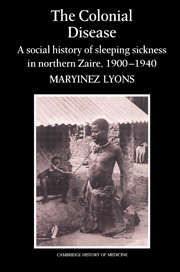Book contents
- Frontmatter
- Contents
- List of maps
- List of plates
- List of tables
- Preface
- List of abbreviations
- Map 1 Africa: political
- 1 Disease and medicine in the history of Africa
- 2 From private empire to public colony
- 3 Mise en valeur: economic exploitation
- 4 Epidemiology and ecology of human sleeping sickness
- 5 ‘The Lure of the Exotic’: sleeping sickness, tropical medicine and imperialism
- 6 Discovery: Liverpool scientists in the Congo
- 7 The campaign. Part one: sleeping sickness and social medicine
- 8 The campaign. Part two: the surveys and tensions
- 9 The African response
- 10 Public health, social engineering and African lives
- 11 Conclusion and legacy
- Appendices
- Notes
- Select bibliography
- Index
6 - Discovery: Liverpool scientists in the Congo
Published online by Cambridge University Press: 06 January 2010
- Frontmatter
- Contents
- List of maps
- List of plates
- List of tables
- Preface
- List of abbreviations
- Map 1 Africa: political
- 1 Disease and medicine in the history of Africa
- 2 From private empire to public colony
- 3 Mise en valeur: economic exploitation
- 4 Epidemiology and ecology of human sleeping sickness
- 5 ‘The Lure of the Exotic’: sleeping sickness, tropical medicine and imperialism
- 6 Discovery: Liverpool scientists in the Congo
- 7 The campaign. Part one: sleeping sickness and social medicine
- 8 The campaign. Part two: the surveys and tensions
- 9 The African response
- 10 Public health, social engineering and African lives
- 11 Conclusion and legacy
- Appendices
- Notes
- Select bibliography
- Index
Summary
The scientists
On 23 September 1903 the team of scientists from Liverpool arrived in the Congo Free State to begin assessing the public health situation, particularly with reference to sleeping sickness. The Twelfth Expedition of the Liverpool School of Tropical Medicine consisted of Doctors Joseph Everett Dutton, 28, John Lancelot Todd, 27, and Cuthbert Christy, 40, each of whom recently had taken part in previous trypanosomiasis research expeditions in Africa. Dutton had participated in the Third Expedition concerned with malaria in Nigeria in 1900 and in two expeditions dealing with trypanosomiasis, in 1901 and 1902, both to Senegambia. Cuthbert Christy, a most difficult and irascible man, had been briefly attached to the Royal Society's first sleeping sickness commission to Uganda in 1902. When they reached the Congo Free State, the British team was joined by Dr Inge-Valdemar Heiberg, a reserve captain in the Norwegian army, who was one of the many non-Belgian military doctors employed by the State. Heiberg's career of six terms spanned nearly twenty years. Beginning as a médecin d'expedition in the Lado enclave, he became director of the first sleeping sickness lazaret at Ibembo in 1907 and the first médecin en chef of the Congo on 28 January 1911. As an illustration of the small number of tropical health specialists at the time, Dutton and Todd were already acquainted with Heibert whom they had met in Liverpool where he had completed the new tropical medicine course in May 1903. Dutton explained, ‘We were delighted when he told us that he was put at our disposition and was to act as a guide, aide-de-camp and everything else.’
- Type
- Chapter
- Information
- The Colonial DiseaseA Social History of Sleeping Sickness in Northern Zaire, 1900–1940, pp. 76 - 101Publisher: Cambridge University PressPrint publication year: 1992

